Excerpts from Jim Conrad's
Naturalist Newsletter
from the May 22, 2016 Newsletter issued from Hacienda Chichen Resort beside Chichén Itzá Ruins; limestone bedrock; elevation ~39m (~128ft), N20.675°, W88.569°; central Yucatán state, MÉXICO
STRANGLER FIG
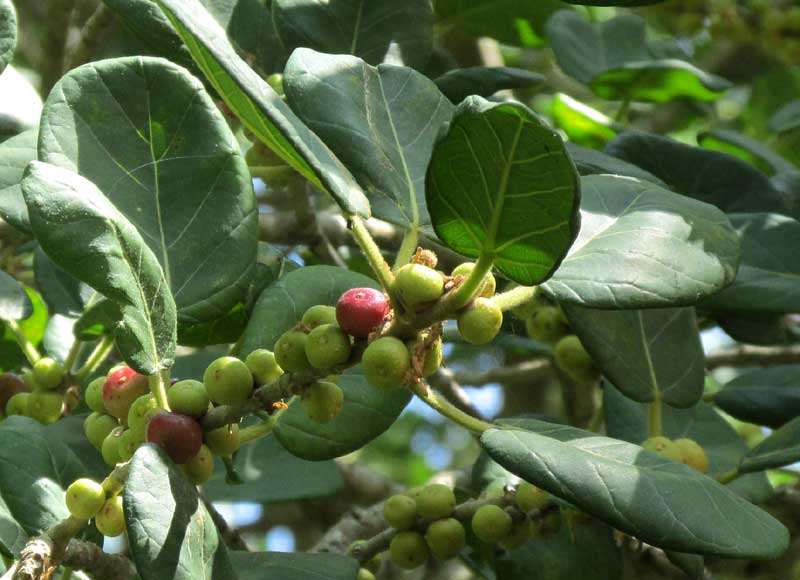
Eight fig species -- members of the genus Ficus -- are listed as native to the Yucatan, so at the Hacienda I've been waiting for a very conspicuous one next to the entry road to fruit so I could identify it. This week when suddenly this tree's branches grew animated with birds hopping from branch to branch, I was delighted, for the birds were feeding on the figs I've been waiting for. Each afternoon my 4PM walk of the garden visits this very tree because it's one of the main attractions. Below, you can see the noble and strange species' trunk and lower limbs:
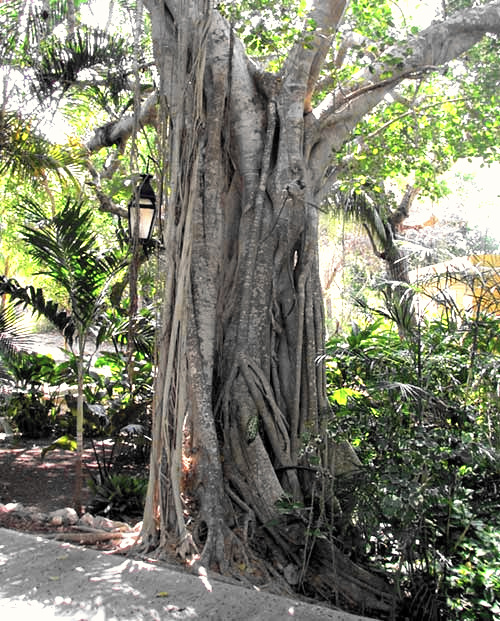
The trunk is formed from many fused-together aerial roots. A close-up showing how these individual "root-stems" intertwine, eventually grafting together and merging where they touch, is shown below:
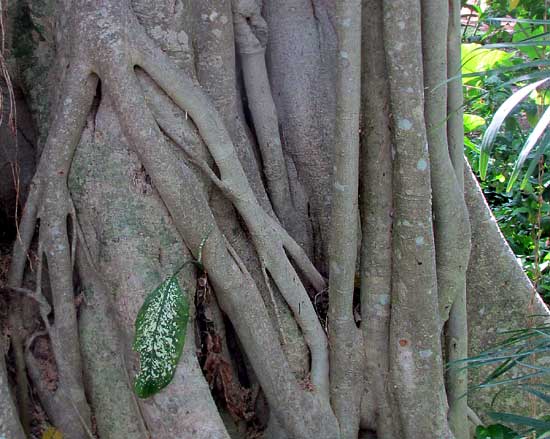
The same process taking place with larger stems and branches can been seen below:
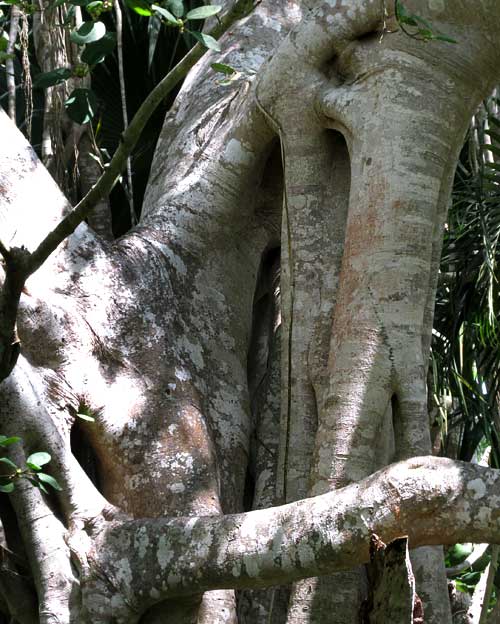
Remarkable as this is, several fig species produce such mutually grafting stems, so to identify this one I had to pay close attention to the leaves and fruits. A typical branch showing numerous pea-sized figs closely clustering along a stem, with mature figs turning red at maturity, is shown at the top of this page.
A flash-assisted shot from below shows the leaves' bases extending a little back from their points of attachment with the petioles -- the leaf bases are "chordate" -- and that the leaves' five or so pairs of veins join near the blades' margins, is shown below:
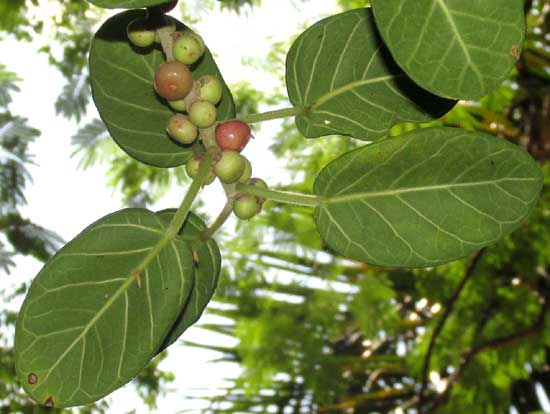
Finally, a handful of the long-awaited, small, red figs is shown below:
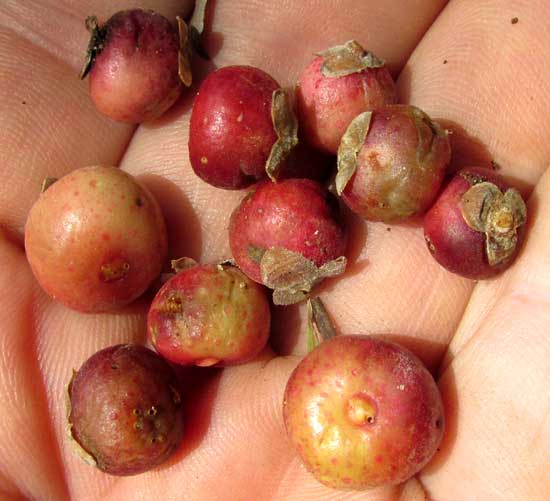
The leaves' long petioles, the few pairs of veins (5-8), the figs' lack of any stalk, and their red color at maturity all lead to the name FICUS COTINIFOLIA. Local people tend to call our tree a Laurel, though it's not a laurel, or Alamo, which elsewhere usually means "poplar," or even Encino, though usually that means "oak." When I call it a fig tree, an higo, I lose all credibility here, so I just share my plant thoughts with visitors. In English, about the best we can do is to call our Hacienda tree a Strangler Fig, though that's a general name applied to all fig species demonstrating this tree's growth form.
By the way, how can you know that this is a fig and not a poplar, laurel or oak? Two important field marks are that the tree's leaves and stems exude milky latex when wounded, and that the woody stems are encircled by stipule scars or "rings" at every leaf node. However, at this season the main proof is that the trees are loaded with figs, and figs are such unusual fruiting bodies that they can't be confused with anything else. A cut-open fig from our Ficus cotinifolia is shown below:
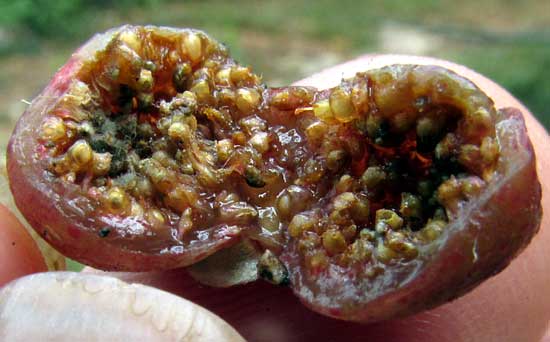
The extraordinary thing about a fig is that it's not really a fruit. Rather, it's a platform, or "receptacle," bearing many mixed unisexual flowers and/or fruits on one side. The receptacle curves upon itself, forming a ±spherical "synconium," with flowers and fruits on its inside surface. Each of those grainy things inside the cut-open synconium in the above picture is a flower or true fig fruit.
Part of the amazing story of strangler figs is that fig seeds often are deposited on tree limbs well off the ground. There the seed germinates and for awhile the plant lives as an epiphyte, taking water and nutrients from what's available aboveground, like most bromeliads and many orchids and aroids. The epiphyte strangler sends slender aerial roots toward the ground. When these roots penetrate the ground and gain access to more water and nutrients, explosive growth of the plant takes place, the roots enlarge, encircle the host-tree's trunk, the fig grows above its host, overshadowing it, and slowly the strangler fig "strangles" its host by out-competing it for resources. Eventually the strangler stands where the host once stood, its trunk looking like that of a regular tree. It's an amazing story.
How does the fig seed get onto a host tree's branch? Often it's explained that seeds stick to bird beaks and when the birds fly to other trees to clean off their bills the seeds are planted then. That's probably true, but I suspect that the most common travel mode is displayed in a picture of an Elephant Ear's leaf below the Hacienda tree, shown below:
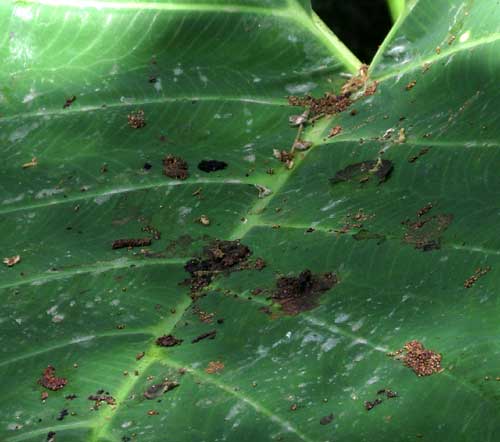
The leaf is covered with bird poop full of Ficus cotinifolia seeds, and trees and shrubs throughout the vicinity are similarly ornamented.
Ficus cotinifolia occurs throughout most of tropical, humid Mexico and continues south to Costa Rica. It occupies a variety of habitats, from pine forests to coastal dunes and mangroves, to secondary forests, and as such displays much variability in its appearance.
The figs of Ficus cotinifolia, despite how birds and other critters crave them, are so small and tasteless that people don't bother eating them. However, the tree's milky latex has been used in traditional medicine against asthma and intestinal parasites. In ancient times the Maya used the tree's soft inner bark for making "amate" paper. The Maya books burned by the invading Spaniards mostly were made from this tree.